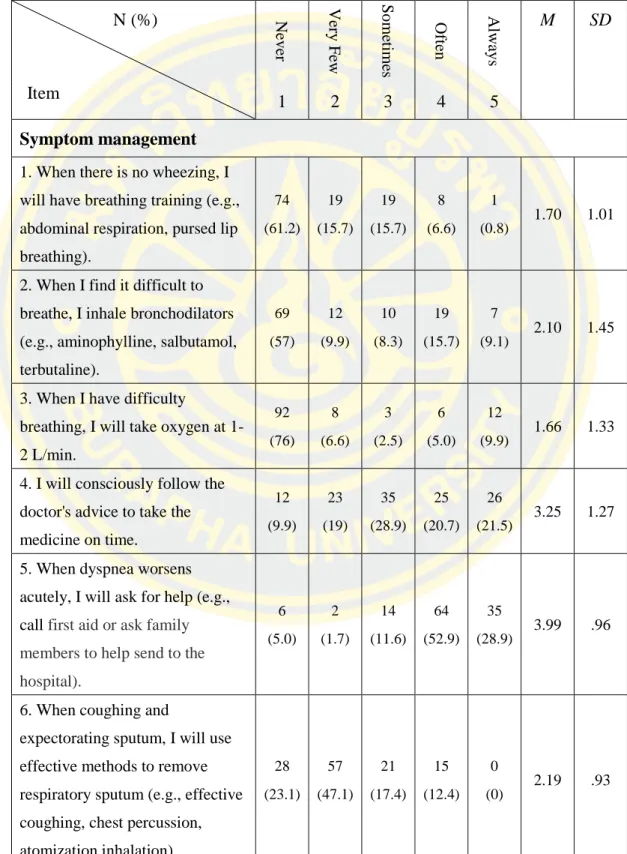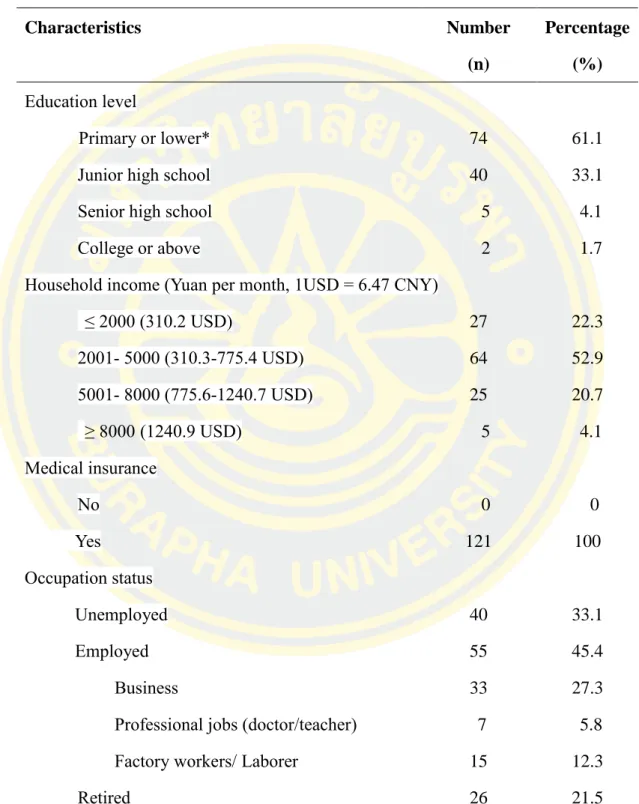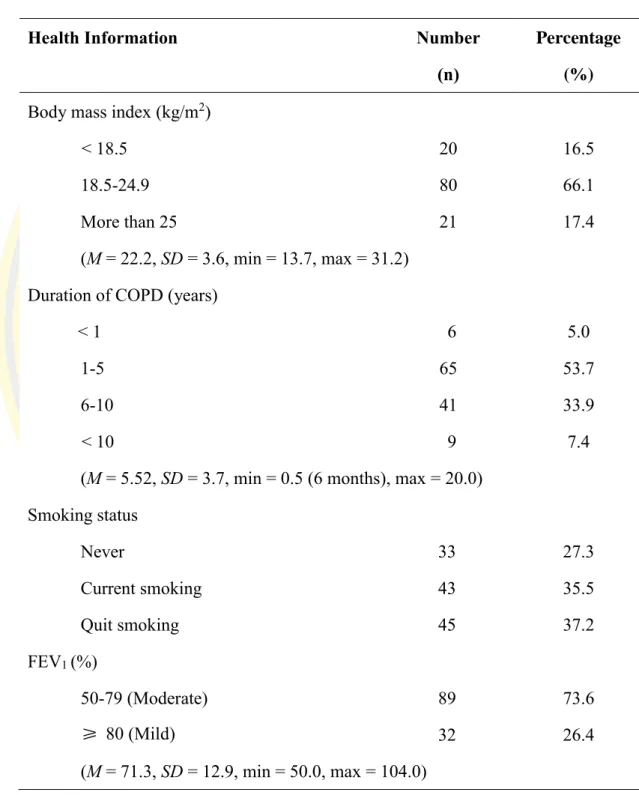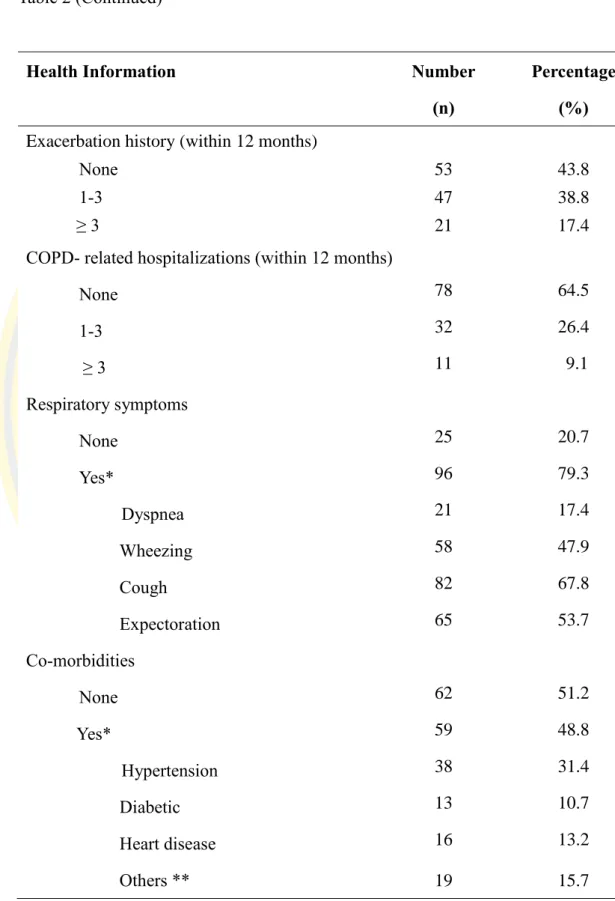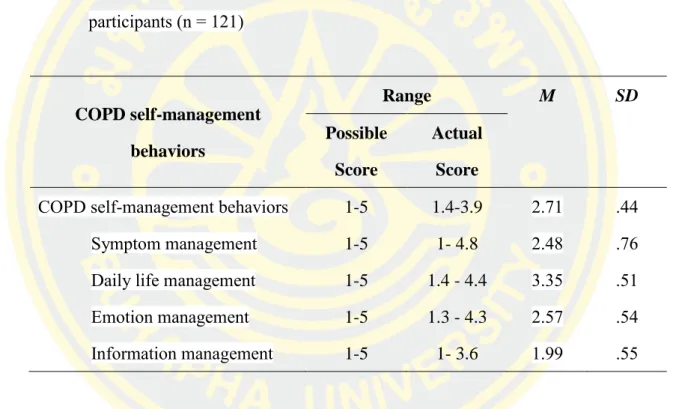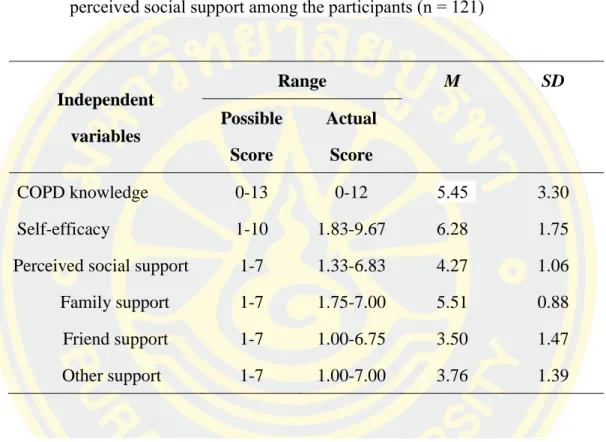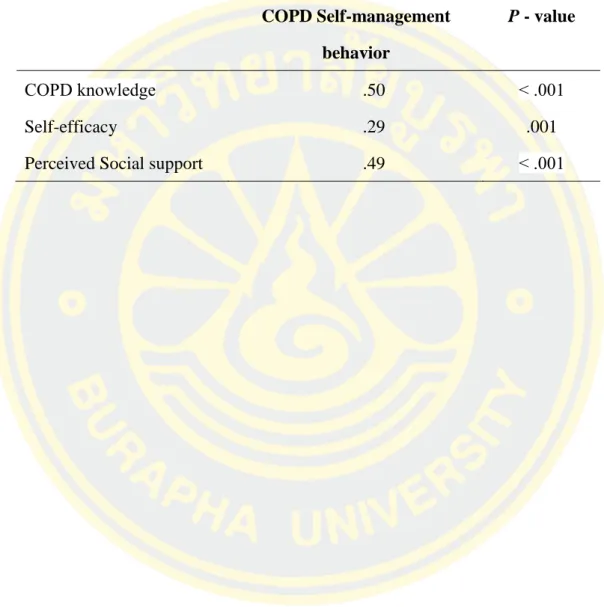This thesis has been approved by the Graduate School of Burapha University in partial fulfillment of the requirements for the Master of Nursing (International Program) in the Adult Nursing track at Burapha University. KEY WORDS: MILD TO MODERATE COPD, SELF-MANAGEMENT, KNOWLEDGE OF COPD, SELF-EFFICACY, PERCEIVED SOCIAL SUPPORT. BEHAVIOR AMONG PEOPLE WITH MILD TO MODERATE CHRONIC OBSTRUCTIVE PULMONARY DISEASE IN WENZHOU, CHINA.
Self-management behaviors have been found to be important for chronic obstructive pulmonary disease (COPD). The aim of this research was to describe the self-management behaviour, and investigate the relationship between COPD knowledge, self-efficacy, perceived social support and self-management behavior among persons with mild to moderate COPD in Wenzhou, China. Research instruments included a demographic data questionnaire, the COPD Self-Management Scale, the COPD Questionnaire, the 6-item Chronic Illness Self-Efficacy Scale, and the Perceived Social Support Scale, each carrying reliability of and .89.
The findings provide evidence for healthcare providers to develop an intervention program aimed at improving COPD knowledge, self-efficacy, perceived social support to promote COPD self-management behaviors among persons with mild to moderate COPD in Wenzhou, China. I also highly appreciate the course leader (International Program) of the Master of Nursing, Assoc. prof. dr.

INTRODUCTION
For persons with mild to moderate COPD, persistence of good self-management behaviors is an essential part of effective treatment (Chinese Medical Association et al., 2018). Moreover, de Sousa Sena et al. 2017) believed that work productivity would flourish among persons with mild to moderate COPD through self-management behaviors. To describe the self-management behavior among persons with mild and moderate COPD in Wenzhou, China.
To determine the relationship between COPD knowledge, self-efficacy, perceived social support, and self-management behavior among persons with mild to moderate COPD in Wenzhou, China. COPD knowledge is positively associated with self-management behaviors among persons with mild to moderate COPD in Wenzhou, China. Self-efficacy is positively related to self-management behaviors among persons with mild to moderate COPD in Wenzhou, China.
Perceived social support is positively associated with self-management behavior among subjects with mild to moderate COPD in Wenzhou, China. Self-efficacy refers to the level of confidence that people with mild to moderate COPD have in completing self-management behaviors.
LITERATURE REVIEWS
COPD is a chronic disease characterized by persistent airflow limitation, which is not completely reversible (Chinese Medical Association et al., 2018). 65% of mild to moderate COPD patients in China have at least one respiratory symptom (Fang et al., 2018). Cognitive and symptom control in persons with mild and moderate COPD significantly slows disease progression (Li et al., 2014).
Continuous medication use is a crucial symptom of self-management behavior for patients with COPD (Korpershoek et al., 2017). 46.3% of persons with mild to moderate COPD were nonadherent to healthcare provider treatment (Aredano et al., 2020). Of course, performing self-management behaviors among people with COPD is still problematic especially in the mild to moderate group (Barrecheguren et al., 2018; Fazleen & Wilkinson, 2020).
A cross-sectional study of 4331 Chinese COPD patients by Liu et al. 2020) found that 51.8% of people with mild to moderate COPD currently smoke. The study also found that subjects with mild to moderate COPD were less likely to quit smoking compared to those with severe and very severe COPD (Liu et al., 2020). COPD knowledge refers to a person's understanding of COPD symptoms, medications, and risk factors (Maples et al., 2010).
A review of mild to moderate COPD (n = 577) in the UK found that intervention with social support can improve individuals' physical activity and promote communication with caregivers (Jonsdottir et al., 2015).
RESEARCH METHODOLOGY
The researcher randomly selected 50% of these individuals as a sample by presenting two sheets of paper of the same size and material and writing down the "odd numbers" and "even numbers". Samples were recruited until the required sample size was reached, then recruitment was halted for the next phase of the study. The participants' self-report was obtained from part 1 of the demographic questionnaire, and part 2 was obtained from the participants' self-report and medical record.
In addition, the modified CSMS version deleted these two items “I do not take steroids (eg, prednisone or dexamethasone) when I feel severe shortness of breath” and “I do not take anti-inflammatory drugs when I feel severe shortness of breath”. deviates from the current treatment strategy for COPD patients used in the clinic, because this may negatively affect the reliability of the symptom management part of the questionnaire (Yang et al., 2019). In this study, the Chinese version of the COPD knowledge questionnaire was used to measure the COPD knowledge of patients with mild to moderate COPD. The final score is obtained by dividing the total scale score by the number of items (Fu et al., 2003).
The final total score of the PSSS was summed over 12 items, then divided by 12, which is the score range between 1 and 7 points. For this study, the reliability of the instruments was tested with 30 participants, and Cronbach alpha of CSMC was .86, the COPD-Q was .80, the SES6 was .93, and the PSSS was .87. Before the data collection process, all participants were carefully informed about the purpose of the study and participant procedures.
All data will be destroyed one year after the publication of the research date. After receiving approval from the Faculty of Nursing at BUU, the researcher submitted recommendations for ethical review to the IRB of BUU and the IRB of the First Affiliated Hospital of Wenzhou Medical University in China. The researcher obtained permission from the Faculty of Nursing at BUU and the First Affiliated Hospital of Wenzhou Medical University in China to collect data on the objectives and procedures of the research information.
The researcher randomly selected 50% of these people as a sample by preparing two sheets of paper of the same size and material and wrote down "odd numbers" and "even numbers" respectively. The researcher met and informed the participants and their families about the purpose of the study, ethical issues and human protection. The descriptive statistics were used to describe the frequencies, percentages, means and standard deviations of the mild to moderate COPD subjects' demographic data and variables.
RESULTS
Completed primary school but did not attend secondary school or complete primary school. Participant health information consisting of body mass index (BMI), smoking status, duration since COPD diagnosis, COPD stage, FEV1, history of exacerbations and COPD-related hospitalization within one year, respiratory symptoms , comorbidities, daily COPD treatment, and source of COPD information are illustrated in Table 2. Regarding the participants' disease-related characteristics, the mean BMI of the participants was 22.2 kg/m2 (SD = 3.6).
35.5% of participants reported having a COPD-related hospitalization at least once in the past year. The majority (79.3%) of participants had at least one respiratory symptom, with cough (67.8%) being the most common symptom they experienced. About half of the participants (48.8%) had at least one comorbidity, while hypertension (35.5%) was the most common comorbidity.
59.5% of participants were currently on daily COPD treatment, and 59.5% of them used medication to control COPD every day. COPD self-management behaviors consist of symptom management, daily life management, emotion management, and information management, as shown in Table 3. The lowest score was “I want to talk to the medical staff about things that are upsetting and annoying.
The mean score of symptom management dimension was 2.48 (SD = 0.76), the item with the highest score was "When dyspnea worsens acutely, I will ask for help (eg call emergency services or ask family members to help send to hospital)". The mean score of information management was the lowest with score was 1.99 (SD = 0.55), the item with the highest score was "I will keep the disease-related. Factors related to COPD self-management behavior among persons with mild to moderate COPD in Wenzhou, China.
Factors associated with COPD self-management behaviors, including COPD knowledge, self-efficacy, and perceived social support. Correlations of independent variables with COPD self-management behaviors of participants with mild to moderate COPD used Pearson's product moment test to analyze, and the results are shown in Table 5.
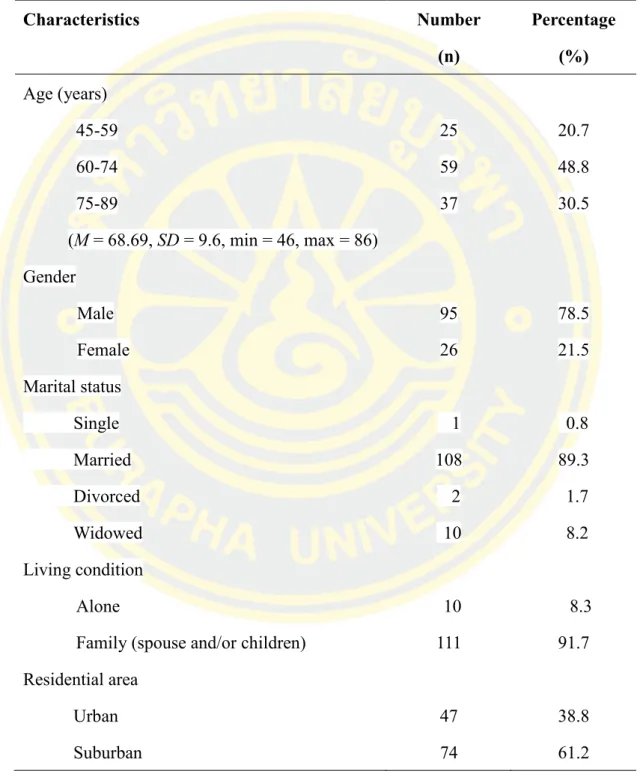
CONCLUSION AND DISCUSSION
Self-management behavior scores were low, indicating that the persons with mild to moderate COPD had poor self-management behavior. This meant that persons with mild to moderate COPD in Wenzhou had lower self-management behaviors. COPD knowledge and self-management behavior were associated in mild to moderate COPD populations, consistent with the hypothesis of this study.
The present study shows that self-efficacy was related to self-management behaviors among persons with mild to moderate COPD. This study showed that the self-management behaviors of people with mild to moderate COPD in Wenzhou were not ideal. This study provided useful information about the self-management behaviors and associated factors of persons with mild to moderate COPD in Wenzhou, China.
Administrators can also include self-management behaviors in the standard of care for people with mild to moderate COPD. Effect of self-management intervention based on self-efficacy theory in patients with chronic obstructive pulmonary disease. A randomized controlled trial of a literacy-sensitive self-management intervention for patients with chronic obstructive pulmonary disease.
Relationship of self-efficacy to self-management behavior of patients with chronic obstructive pulmonary disease. The correlation of self-management and DOSIS index among patients with chronic obstructive pulmonary diseases. Study for the co-relationship of health literacy and self-management for patients with chronic obstructive pulmonary disease.
Study on the status and influencing factors of self-management in patients with chronic obstructive pulmonary disease. Responses to questions on the COPD Self-Management Scale (CSMS) and COPD Knowledge Questionnaires (COPD-Q) (Number and attendance of participants). Study title: …Factors associated with self-management behaviors among persons with mild to moderate chronic obstructive pulmonary disease in Wenzhou, China.
My study is "Factors associated with self-management behavior among persons with mild to moderate chronic obstructive pulmonary disease in Wenzhou, China". Study title: Factors associated with self-management behavior among subjects with mild to moderate chronic obstructive pulmonary disease in Wenzhou, China.
